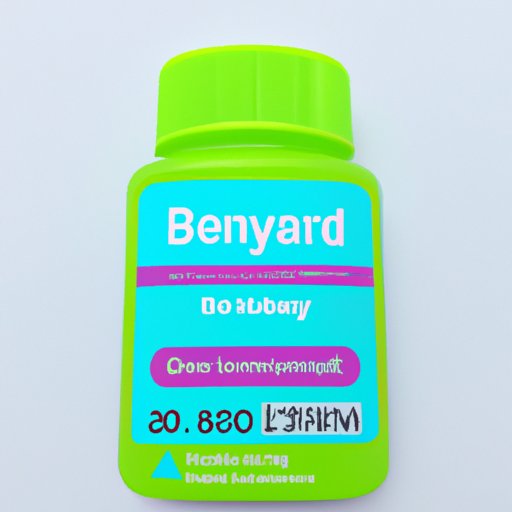Introduction
Benadryl is a commonly used antihistamine that can provide relief for allergy or cold symptoms. Despite its medicinal purpose, some people have found recreational use of this medication. However, taking too much Benadryl can result in dangerous side effects, such as hallucinations, delirium, and seizures. In this article, we explore how many mg of Benadryl it takes to trip and the potential dangers and risks associated with recreational use.
The basics of Benadryl dosing: understanding the safe limit
Benadryl, also known as Diphenhydramine, is an over-the-counter medication used to treat allergy symptoms, such as itching, sneezing, and runny nose, as well as motion sickness and insomnia. It is important to use Benadryl only as directed by a physician or the instructions on the label. The recommended dosage for adults is 25-50 mg every 4-6 hours, not exceeding 300 mg per day. However, an excessive amount of Benadryl can cause serious side effects, such as rapid heartbeat, dizziness, blurred vision, and difficulty urinating.
How much Benadryl does it take to trip? A closer look at the science
The term “trip” refers to a psychedelic experience, which means a state of altered consciousness or perception. The required amount of Benadryl to trip varies among individuals and depends on various factors, such as body weight, tolerance, general health, and other medications used. Usually, people who take Benadryl recreationally consume a much higher dosage than 300 mg. However, consuming excessive amounts of Benadryl can result in serious health risks.
Benadryl contains a chemical compound known as diphenhydramine, which has sedative and hallucinogenic properties. When taken in large doses, diphenhydramine can cause delirium, confusion, and a heightened sense of awareness. This is because diphenhydramine blocks the action of acetylcholine, a neurotransmitter that is responsible for several physiological functions, including memory, arousal, and muscle movement. By inhibiting the action of acetylcholine, diphenhydramine can lead to hallucinations, vivid dreams, and other dissociative symptoms.
The dangers of taking too much Benadryl
Overdosing on Benadryl can have severe consequences. The short-term effects may include dizziness, dry mouth, blurred vision, and difficulty urinating. In some cases, overdosing can cause seizures, irregular heartbeat, and loss of consciousness. Long-term use of Benadryl can also result in cognitive impairment, memory loss, and dementia. In addition, the risk of developing dependence on Benadryl increases with long-term use, leading to withdrawal symptoms when the medication is stopped.
What happens when you take more Benadryl than recommended?
Exceeding the recommended dosage of Benadryl can have immediate effects on the body. Some of the physical symptoms include dry mouth, dizziness, rapid heartbeat, and difficulty urinating. Psychological symptoms may include confusion, anxiety, delirium, and hallucinations. These effects can be especially dangerous when driving or operating heavy machinery. Combining Benadryl with other drugs, such as alcohol or prescription medication, can also result in serious health risks and should be avoided.
Dos and Don’ts: How to safely experiment with Benadryl
If you are considering experimenting with Benadryl, it is crucial to approach it with caution and take proper safety measures. Before trying Benadryl, consult with a healthcare professional or a substance abuse specialist. Starting with a small dose is important, and it is also essential to have a trustworthy person present during the experience. Measuring the correct amount of Benadryl is also important, as overdosing can lead to dangerous side effects. Reducing potential harm can be done by staying hydrated, avoiding other substances, and having a safe space to recover.
The effects of a Benadryl trip: a personal experience
Personal experiences with Benadryl trips can vary, with some people reporting euphoric experiences while others report terrifying hallucinations and paranoia. One person reported experiencing a sense of separation from their body, followed by vivid and detailed visual hallucinations, until eventually passing out. It is important to note that not everyone who takes Benadryl will experience a “trip” and that the effects can be unpredictable and dangerous.
Alternatives to taking excessive amounts of Benadryl for recreational purposes
While it may be tempting to experiment with substances, there are healthier alternatives to spending recreational time. Finding hobbies or activities that promote wellbeing and physical activity can be a source of fun and happiness. Substance abuse treatment options are also available to help overcome addiction or dependence on drugs. If you or someone you know is struggling with substance abuse, seeking help from a professional is crucial and could save a life.
Conclusion
Taking excessive amounts of Benadryl can result in dangerous side effects and pose serious health risks, including addiction and long-term cognitive impairment. While recreational use may seem appealing, the potential dangers and unpredictable effects should not be taken lightly. Experimenting should be done with caution, in a safe environment, and with medical supervision. Finding healthier alternative activities can provide beneficial effects on mental and physical wellbeing, without endangering one’s health or safety.
(Note: Is this article not meeting your expectations? Do you have knowledge or insights to share? Unlock new opportunities and expand your reach by joining our authors team. Click Registration to join us and share your expertise with our readers.)
